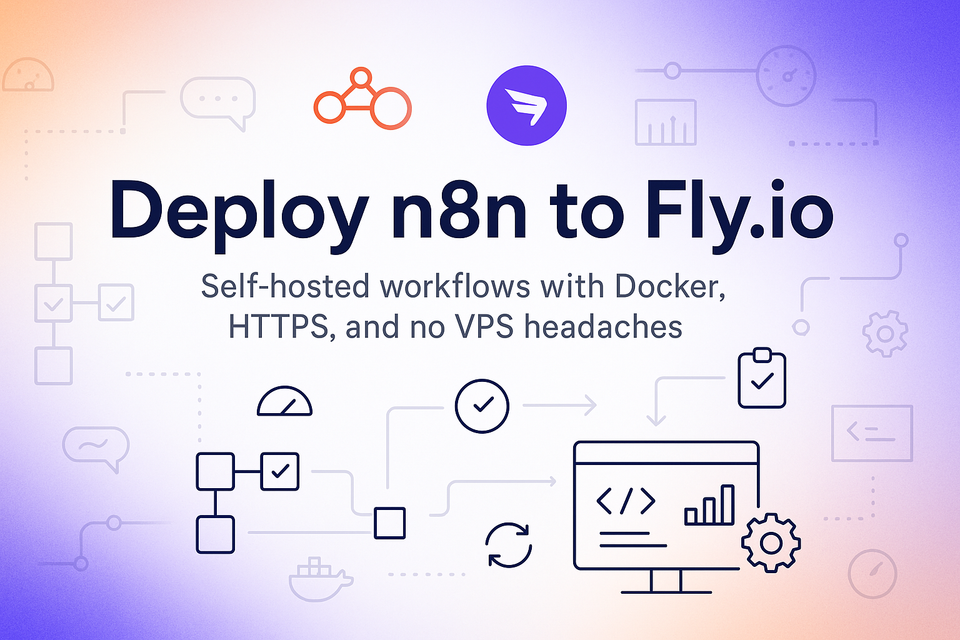Deploy n8n to Fly.io

🌟 Why Fly.io?
Fly.io is a great platform for hosting self-managed apps like n8n. Here’s why:
- 🧠 No VPS maintenance – No need to patch, update, or secure an entire virtual machine.
- 🌍 Global regions – Run your app close to your users with worldwide data centers.
- 🔐 Automatic HTTPS – Fly provides TLS via Let's Encrypt with no config required.
- 💾 Persistent volumes – Store workflows and credentials securely and reliably.
- ⚡️ Fast and efficient – Fly’s “Machines” model allows quick restarts and minimal idle costs.
It’s like the developer experience of Heroku, but with the power of Docker and infrastructure-as-code.
🧰 Prerequisites
- ✅ A Fly.io account
- ✅
flyctlinstalled - ✅ Docker installed
- 🌐 (Optional) A custom domain for your n8n instance
🗂 Project Structure
Your folder should contain:
n8n-fly/
├── Dockerfile
├── fly.toml
└── config.json (optional)🐳 Dockerfile
Use the official n8n Docker image, pinned to a stable version:
FROM n8nio/n8n:1.44.0
COPY config.json /home/node/.n8n/config.jsonFilename: Dockerfile
📌 Why pin the version?
To prevent unexpected changes when latest updates.
⚙️ fly.toml Configuration
Example configuration:
app = "n8n"
primary_region = "fra"
[build]
dockerfile = "Dockerfile"
[env]
PORT = "5678"
N8N_RUNNERS_ENABLED = true
N8N_ENFORCE_SETTINGS_FILE_PERMISSIONS = true
N8N_HOST = "n8n.xqus.com"
N8N_PORT = 5678
N8N_PROTOCOL = "https"
N8N_EDITOR_BASE_URL = "https://n8n.xqus.com"
[http_service]
internal_port = 5678
force_https = true
auto_stop_machines = "stop"
auto_start_machines = true
min_machines_running = 1
processes = ["app"]
[mounts]
source = "n8n_data"
destination = "/home/node/.n8n"
[[vm]]
memory = "1gb"
cpu_kind = "shared"
cpus = 1fly.toml
🌍 Region Tip
The primary_region should be closest to your users (e.g. fra for Frankfurt, ord for Chicago).
View the full list of regions here: https://fly.io/docs/reference/regions/
🔐 Set Secrets with fly secrets
No need for a .env file — just store secrets securely:
fly secrets set \
N8N_ENCRYPTION_KEY=e9Fzr!nT&0tjBYDn6gv \
N8N_BASIC_AUTH_ACTIVE=true \
N8N_BASIC_AUTH_USER=yourusername \
N8N_BASIC_AUTH_PASSWORD=yourpassword🔑 Never commit secrets to your codebase!
💾 Create Persistent Volume
Create a volume to store credentials and workflow data:
fly volumes create n8n_data --size 1 --region fra
📌 The region must match your app’s primary_region.
🚀 Deploy Your App
Use either of these:
🔧 Run the guided setup:
fly launch
⬆️ Or deploy manually:
fly deploy
🌐 Custom Domain + HTTPS
If you want to use your own domain (e.g. n8n.yourdomain.com) instead of the default your-app.fly.dev, follow these steps:
1. 🔧 Add your domain in Fly.io
Tell Fly which domain you’re using:
fly certs add n8n.yourdomain.com
This sets up automatic TLS (HTTPS) using Let's Encrypt.
2. 🌐 Update your DNS
Create a DNS A record pointing to your Fly app’s IPv4 address:
- Run
fly ips listto get your app’s public IP. - In your DNS provider, add:
Type: A
Host: n8n
Value: [YOUR_FLY_PUBLIC_IPV4]
TTL: Automatic or 300
Example: If you’re using Cloudflare, add a DNS A record forn8npointing to1.2.3.4(your Fly IP).
Optional: If your DNS provider supports CNAME flattening or ANAME/ALIAS records, you can also point the root domain (@) to your Fly app.
3. ✅ Done!
Once DNS is propagated (usually within minutes), Fly.io will automatically issue and renew an HTTPS certificate for your domain.
You can verify with:
fly certs show n8n.yourdomain.com
✅ You're Live!
Your n8n instance is now deployed with:
- HTTPS
- Docker
- Persistent storage
- Fly.io’s global platform
- Zero VPS overhead
🎉 Open your custom domain or https://n8n.fly.dev to start using n8n.
🔄 How to Update n8n to the Latest Version
Want the newest features or security patches? Here’s how to update:
- Check the latest version
- Update your Dockerfile
- Change the version, e.g.
FROM n8nio/n8n:1.46.0
- Change the version, e.g.
- Redeploy
- Run:
fly deploy - Fly will rebuild and restart the app using the new version.
- Run:
- Verify
- Open your instance → Settings → About → Confirm the version number
That’s it! All workflows and credentials will stay intact.
📌 Final Reminders
- 🔐 Back up your
N8N_ENCRYPTION_KEY— losing it means losing access to stored credentials. - 🧪 Test everything after deploying updates or new secrets.
- 📦 You can clone this setup for multiple environments by changing
appandregion.